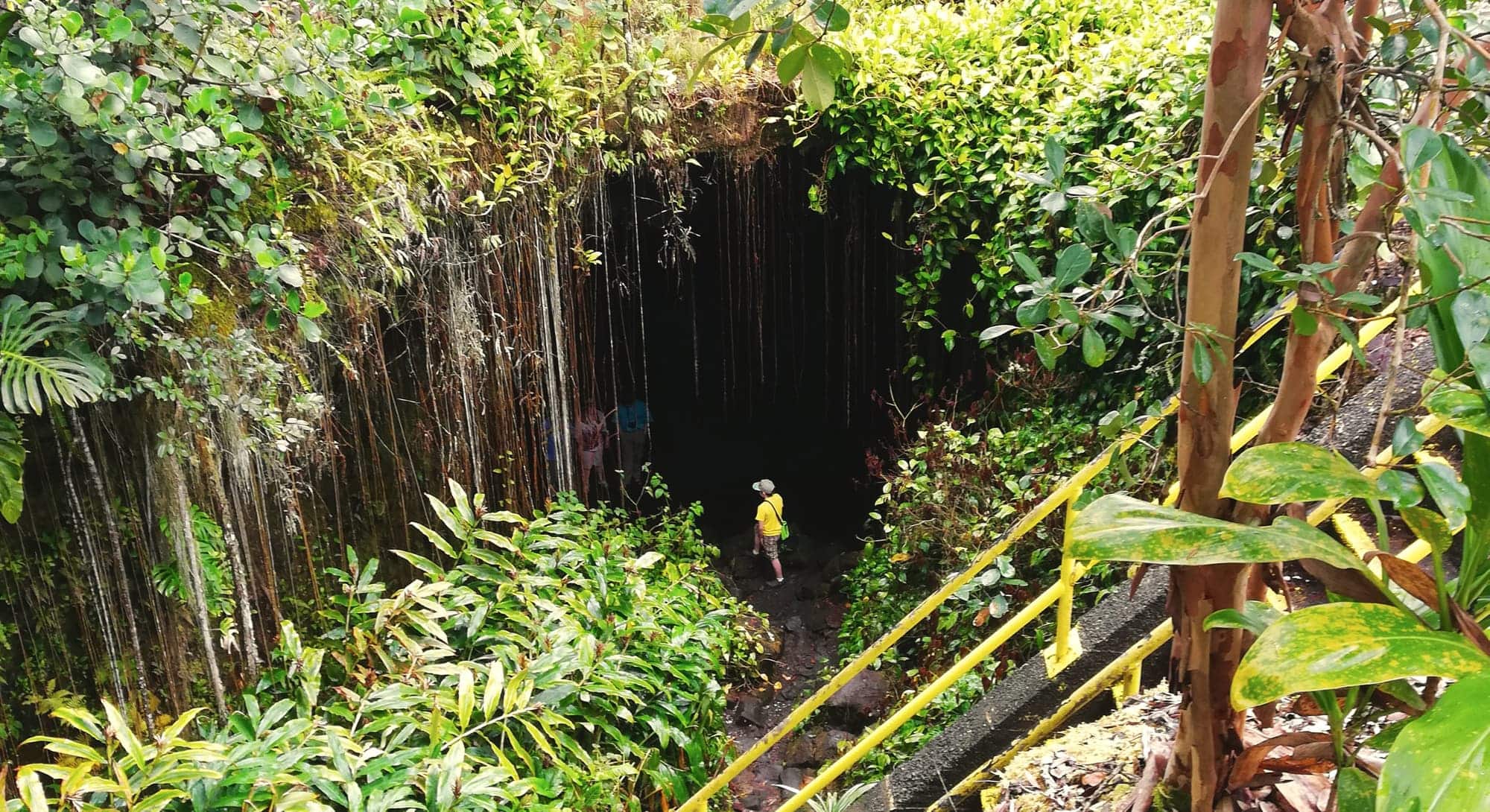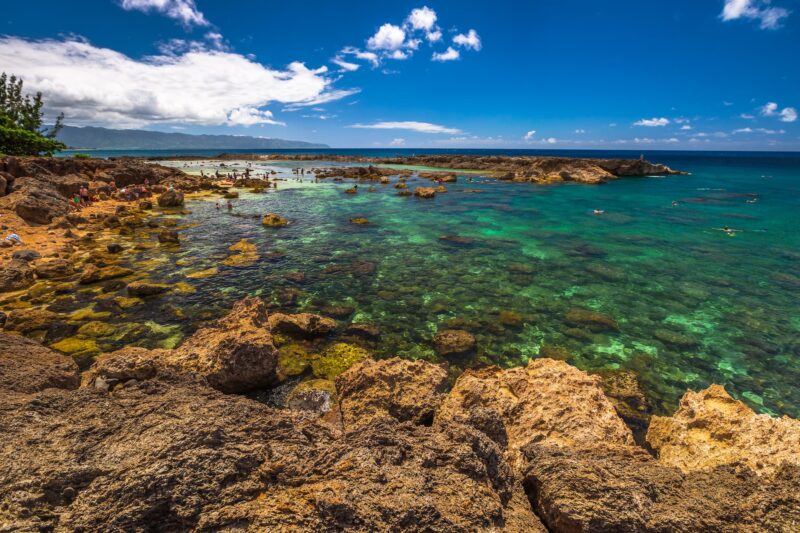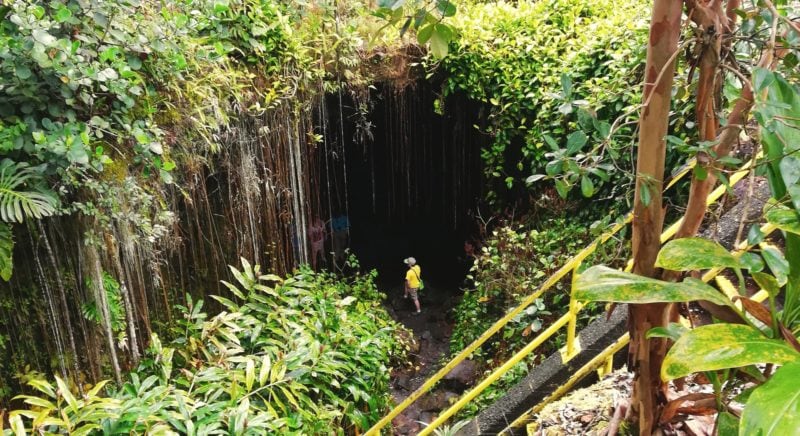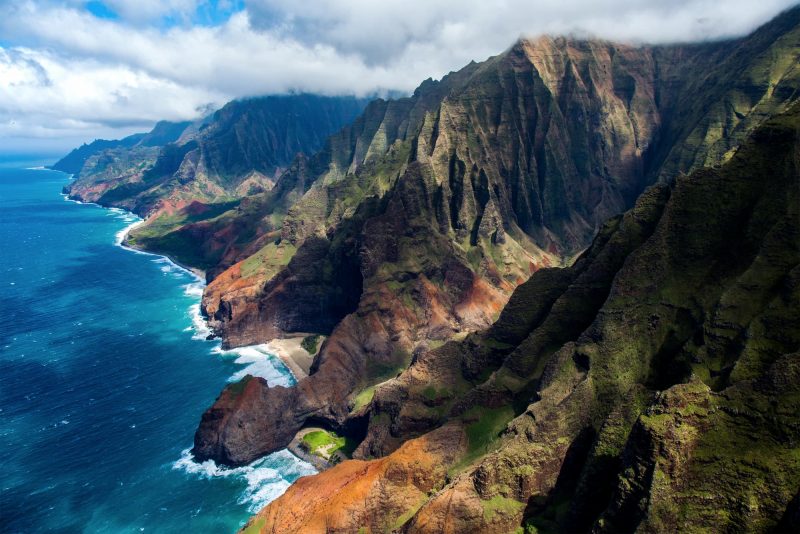Exploring Hawaiʻi’s lava tubes is an adventurous way to experience the beautiful, rugged geological history of the islands and learn more about how an erupting volcano transports lava underground.
Lava tubes are found throughout the Hawaiian Islands. These underground tubes are the plumbing system for volcanoes, transporting lava to different eruptions sites. They come in many discoverable shapes and sizes, some millions of years old, and others active more recently here in the present.
Table of contents
- Lava Tubes on Oahu
- Lava Tubes on the Big Island
- Lava Tubes on Maui
- Lava Tubes on Kauai
- 4 Types of Lava Tubes (with examples and where to find them)
Table of Contents
- Lava Tubes on Oahu
- Lava Tubes on the Big Island
- Lava Tubes on Maui
- Lava Tubes on Kauai
- 4 Types of Lava Tubes (with examples and where to find them)
Below are a variety of our lava tube recommendations, broken down by island, with information about the best way to experience them.
A note to our readers: please be respectful and use common sense while visiting a lava tube, so that future generations share in the wonder then can evoke now. Please don’t break off rocks or take loose rocks out of the caves, don’t leave trash, and don’t vandalize the cave walls using spray paint or sharp objects. Mahalo nui loa!
Oʻahu Lava Tubes
Despite being the most developed island, lava tubes and their remnants can still be found on Oʻahu.
Halona Blowhole
Why go: Believe it or not, there aren’t many blowholes in the Hawaiian Islands, making the ones we do have even more special. The Halona Blowhole on Oʻahu’s south shore is located in a beautiful area, with easy parking, and serves as a great stop on scenic drives along this part of the island’s coast.
Good to know: There’s a small path on the west side of the parking area that leads down to a small beach cove. Feel free to explore, but be mindful on the path going down and watch the ocean closely when exploring the beach and rocks. We don’t recommend swimming here due to strong waves and sharp rocks.
How to visit: You can find the parking lot for Halona Blowhole just adjacent to Sandy Beach Park. It is clearly marked. Drive slow and watch for cars entering and exiting.
Combine with: A scenic drive along the southeast shore! There’s so much to see in this area, including large sea cliffs as well as notable attractions like Koko Crater, Hawaiʻi Kai Marina, Hanauma Bay, the easy Makapuʻu Lighthouse trail, and Sandy Beach Park.
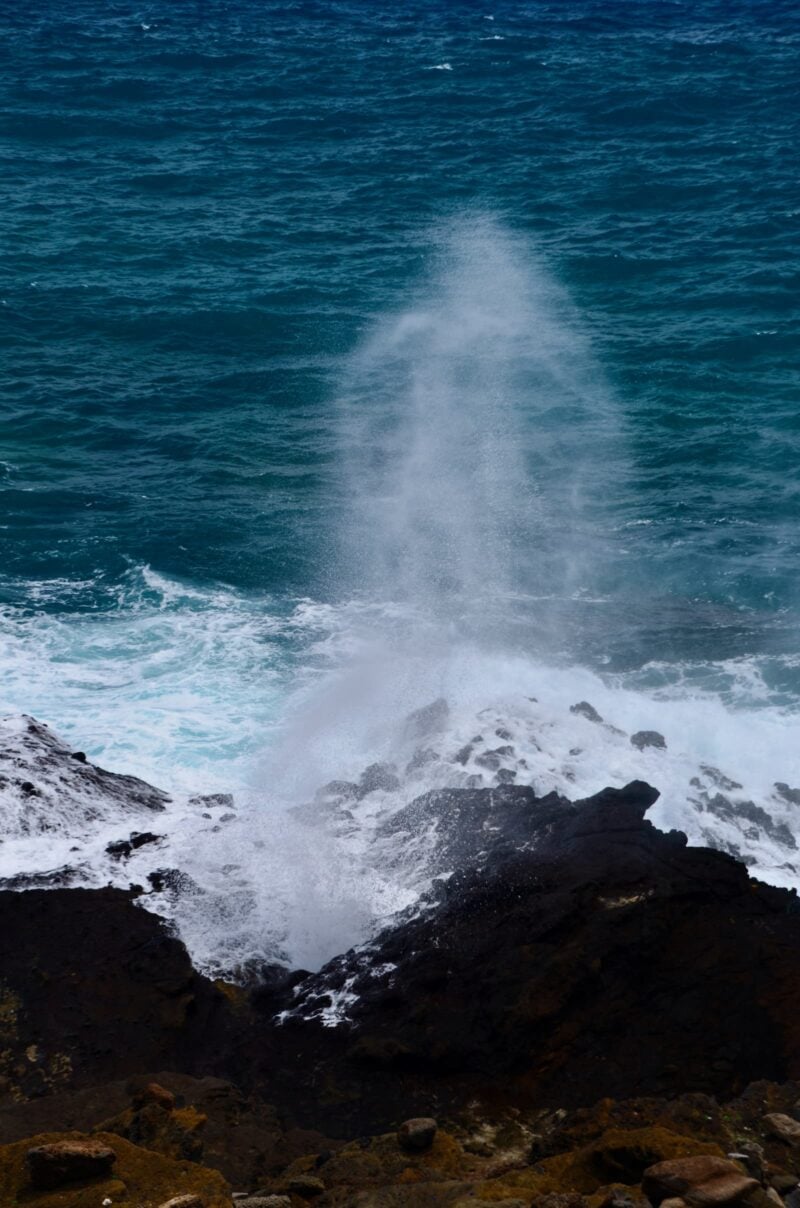
The Halona Blowhole on Oʻahu. © CC BY-SA Thomas Tunsch / Halona Blowhole (source)
Shark’s Cove
Why go: Shark’s Cove is a popular snorkeling area for both beginner and experienced swimmers. You can think of the main area at Shark’s Cove as one large tide pool, offering calm water (in summer, see below) and a safe place for children to snorkel and swim.
Outside that main area, things get more advanced, with underwater sea arches and caves left over from lava flows. Experienced snorkelers, free divers, and scuba divers will have fun exploring this underwater area.
Good to know: Shark’s Cove is safe for swimming and snorkeling only in the summer months. During the winter, it receives big swells and strong currents, and we don’t recommend getting in the water during this time of year. As always, consult locals and lifeguards when in doubt.
How to visit: Shark’s Cove doesn’t have an official parking lot, so look for street parking nearby or grab a spot in the nearby Pūpūkea Beach Lot.
Combine with: Shark’s Cove is located across the street from a food truck park, making it a scenic place to have lunch and hang out as you cruise along the North Shore.
Mermaid Caves
Why go: The Mermaid Caves are the remnants of old lava flows, carved out over time by the ocean to form sea caves; they can be explored via skylights in the rocky, porous coastline. On days with calm conditions at low tide, you can enter the caves and poke around inside. Usually, there will be a couple inches to a foot of water inside.
Good to know: The Mermaid Caves could be the coolest place you see during your visit to Hawaiʻi, but it can also be very dangerous. Go only at low tide, and always keep an eye on the conditions. A surge of current or oversized wave can unexpectedly fill the cave with water, sometimes with great force. If in doubt, stay on top of the caves and enjoy the view from above through the skylights.
How to visit: You can find the Mermaid Caves south of Nānākuli Beach Park. Park in the lot for the beach, then walk along the rocky coast south. It is marked on the map.
Combine with: There is much to do along Oʻahu’s west coast, including a visit to Electric Beach for some of the best snorkeling on the island.
Big Island Lava Tubes
As the youngest island in the chain and one that is still forming, lava tubes can be found in abundance on the Big Island, many well-preserved and easily accessible.
See our overview of lava tubes on the Big Island for more caves to explore.
Kaumana Caves
Why go: Kaumana Caves Park is the gateway to a lava tube – in this case, a 25-mile long lava tube that was created by Mauna Loa’s 1881 flow. You can enter the lava tube and explore about two miles of it via the entrance at this park, which is similar to the experience of exploring a cave, or hiking underground. While it requires appropriate caution (see below), hiking through the tube is an eye-opening experience, with some caverns reaching 30 feet in height.
Good to know: Entering a lava tube such as the Kaumana Caves requires proper preparation, as low ceilings, ledges, and outcroppings make it easy to bump your head or trip and fall. The height of the cave varies from 30 feet to less than 3 feet in some deeper sections. A few other tips:
- To hike beyond the first 100 yards, you will need to bring a source of light, preferably a headlamp, so you can keep both hands free. Otherwise, a bright handheld flashlight is recommended (i.e., something stronger than your phone).
- Wear appropriate clothing (long pants, sleeves) and sturdy footwear (boots with heavy soles) to protect yourself against the sharp lava rock.
- Walk carefully; it can be slippery inside the cave, and falling on lava rock is not fun. If in doubt, observe the tube/cave from the entrance and tip your hat to its mana, or energy.
How to visit: Follow Saddle Road (Hwy 200) from Hilo to between the 4 and 5 mile marker. The caves are located across the road from the parking lot. To get to the caves you need to climb about 20 ft. down steep stairs, after which you can enter either the left or the right tube. The left starts with a big hall that appears to be a dead end. Look to your right to see a small (4 to 5 ft) opening that you can work yourself through. The cave opens up afterwards and you can follow it for another 15 minutes. The cave on the right is, at least at the start, more easily accessible and can be followed longer.
The park grounds also include picnic tables, a tap with drinking water, and restrooms. No entry fee is required.
Combine with: Explore the caves, then check out nearby Rainbow Falls along the Wailuku River. Both of these sites are great stops when traveling between Kona and the Hawaiʻi Volcanoes National Park.
Thurston Lava Tube (Nāhuku)
Why go: Thurston Lava Tube, or Nāhuku (which literally means “the protuberances” in the Hawaiian language), is one of the most interesting and easily-accessible lava tubes in the entire island chain. Unlike the Kaumana caves, which are raw and wild, Thurston Lava Tube is completely safe and accessible for people of all abilities.
Entering this 500-year-old cave requires only a short walk down a staircase, then following a paved path through a lush rainforest to the entrance. Inside, you walk can see the solidified drips and waves of once-liquid lava along with the beautiful shapes and colors of leftover minerals that have drained from the rocks.
In other words, it showcases the aftermath of a lava flow. It’s one of the main attractions of the Hawaiʻi Volcanoes National Park.
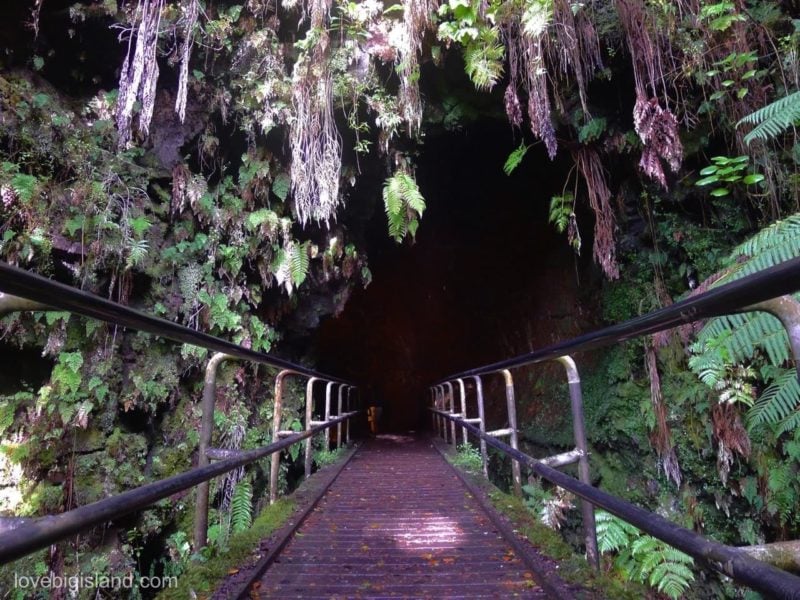
This lava tube was discovered in 1913 by Lorrin Thurston, a local newspaper publisher. At that time the roof of the tube was covered with lava stalactites, but those soon disappeared to souvenir collectors.
Good to know: This site is located within Hawaiʻi Volcanoes National Park, so the park entrance fee is required to visit. Parking is very limited at the Nāhuku parking lot so be patient; it is likely you will have to make several passes. Go early (before 9 am) or later (after 4 pm) to avoid peak hours. If you’re up for a hike, park at the Kīlauea Iki Overlook. You can walk to Thurston from there via a very scenic, half-mile trail.
How to visit: Follow Crater Rim Drive for 1.7 miles (2.7 km) to get to the Nāhuku parking lot.
Combine with: While you are in Hawaiʻi Volcanoes National Park, you might as well continue exploring! There is much to see, including the summit crater, Halemaʻumaʻu, as well as countless other hikes, geological sites, scenic drives, and coastal walks. Stay for the sunset over the crater, and stick around a bit longer for great stargazing.
Maui
Maui’s largest volcano, Haleakalā, has left many of its footprints behind. Two in particular stand out:
Kaʻeleku Caverns
Why go: If you’re looking to experience and explore a very large lava tube on Maui, Kaʻeleku Caverns is where we recommend, allowing you to have a self-guided walk inside the cave, underground. Signs along the way point out facts, helping you keep your eye out for details in the rock, and to understand lava tubes in general.
Good to know: Located on private property, it costs $15 to enter, and a flashlight is provided.
How to visit: Kaʻeleku Caverns is located near Hāna. You can see its exact location here.
Combine with: To get to Hāna, you’ll take the Road to Hāna, which means there is a full day’s worth of activities to experience along the way. Check out our guide to the Road to Hāna for ideas and recommendations.
Waiʻānapanapa State Park
Why go: If you want to check out a sea cave on Maui, head to Waiʻānapanapa State Park near Hāna. Descend the stairs to the black sand beach, then turn right and head along the coast to find the entrance. You can go inside to explore; just keep an eye out for incoming waves.
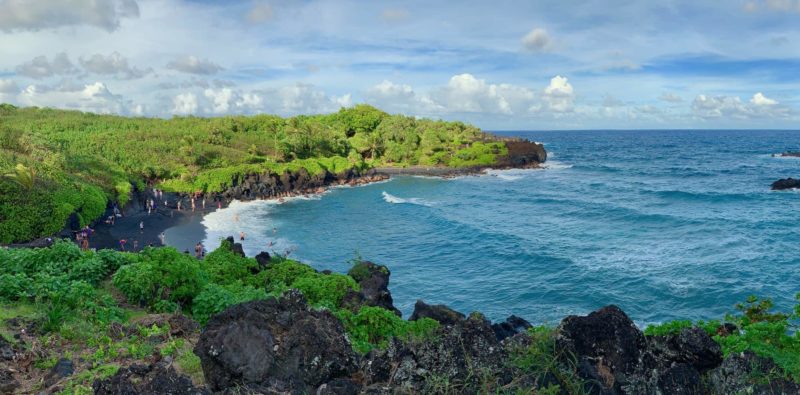
The volcanic black sand beach in the Wai’anapanapa State Park black sand beach is one of the many “must stop” attractions along the Road to Hana. Image credit: Anita Gould, source.
Good to know: Keep watch for blowholes north along the shoreline of Pailoa Bay, which were also formed by lava. There is also a sea arch within the state park.
How to visit: There is a new policy: Visitors to the state park must reserve their entrance and parking in advance online.
Combine with: Take a look at our guide to the Road to Hāna for things to do on your way to Hāna.
Kauaʻi
As the oldest island in the modern day chain, many of Kauaʻi’s lava tubes have been eroded and today take on other forms, including sea caves and blowholes.
- Tunnels Beach (snorkeling + diving)
- Napali Coast
- Spouting Horn Blowhole
Tunnels (Makua) Beach
Why go: Snorkelers and divers rejoice; the underwater world at Tunnels Beach is full of surprises, including coral reefs, tropical fish, and underwater caverns formed by lava tubes. The latter makes the beach one of the best Kauaʻi snorkeling spots and the top scuba diving destination on the north shore of Kauaʻi, also attracting experienced free divers and snorkelers.
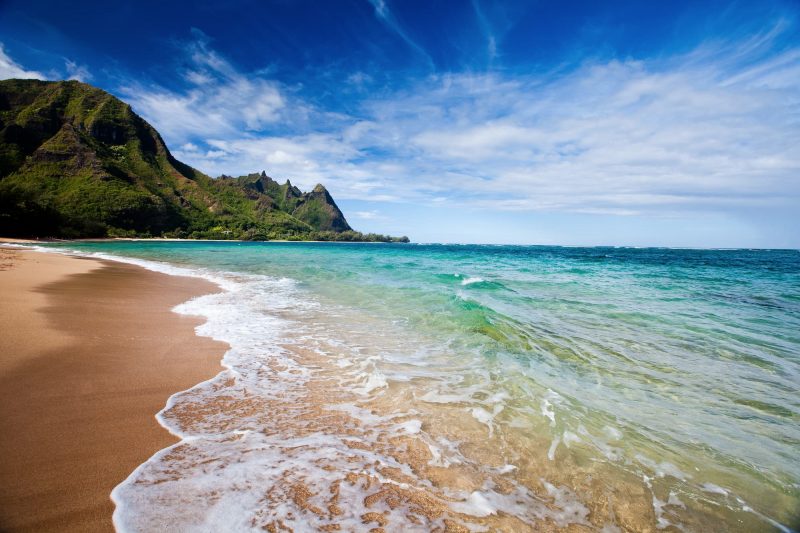
Makua Beach (“Tunnels”) is low-key white-sand beach with shallow reefs for snorkeling Credit: Hawaii Tourism Authority (HTA) / Tor Johnson
Good to know: Exploring the snorkeling area at Tunnels will take time, so bring water or a packed lunch and take plenty of breaks. There are smaller reefs close to shore, suitable for beginners, but the caves are located farther off shore.
How to visit: To get to Tunnels, you’ll have to reserve a parking spot or a seat on the shuttle to Hāʻena Beach Park. Bring your own snorkeling gear to Tunnels. Or, sign up for a scuba diving outing to explore collapsed lava tubes and unique topography features with Dive Kauaʻi.
Combine with: Since you will have to reserve parking or the shuttle, plan on spending the better part of the day at Tunnels and the other beaches on Kauaʻi’s north shore.
Nāpali Coast
Why go: The Nāpali Coast is a stunning, undeveloped area of Kauaʻi located along the northwest coast. It can be explored on foot (via hiking the Kalalau Trail), by air (via helicopter tour), or by a myriad of different boat tours that explore this untouched coastline, full of jagged peaks, expansive valleys, waterfalls, cliffs, and, of course, sea caves and lava tubes.
Good to know: We recommend exploring the Nāpali Coast as one of the top things to do on Kauaʻi.
How to visit: Jump on a boat tour to explore the Nāpali Coast. There are a variety of tours to choose from, depending on whether or not you want to snorkel, and the size of the boat. To experience sea caves, check out the Nāpali Experience.
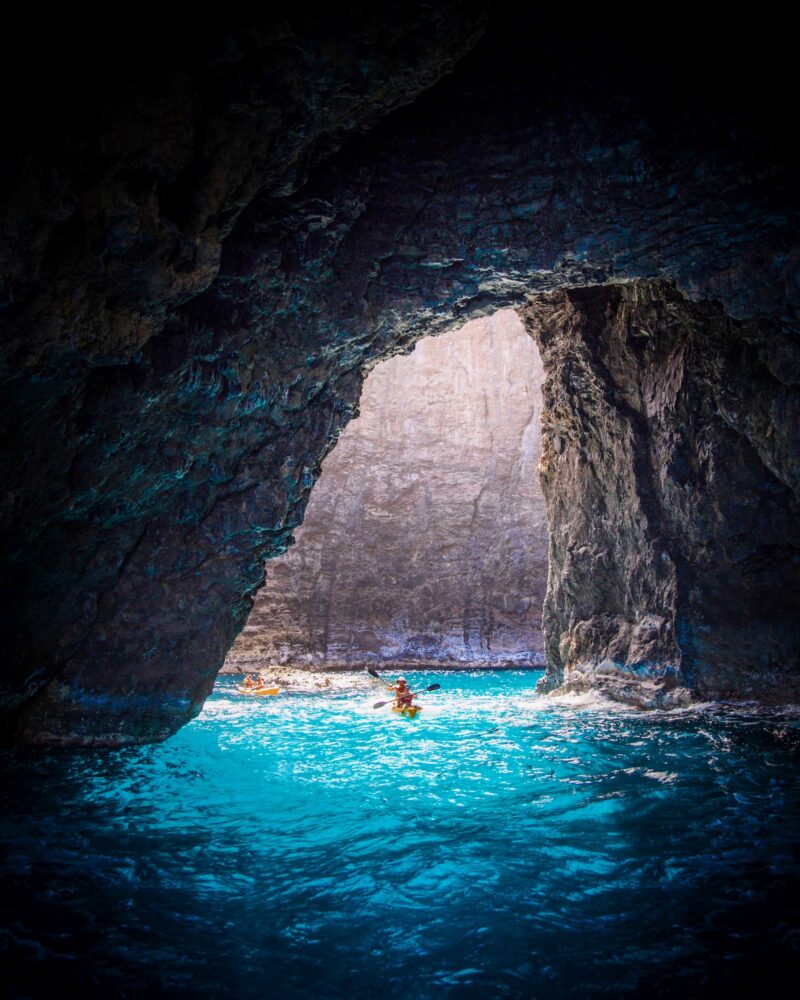
There are many sea caves along the Napali coast on Kauaʻi. Of those caves, Pukalani (the Open Ceiling Cave) is the most popular one. Credit: Hawaii Tourism Authority (HTA) / Tommy Lundberg
Combine with: This will be a half or three-quarter day outing, so consider it your main event for the day. Grab a late lunch or early happy hour after your tour.
Spouting Horn Blowhole
Why go: An easy jaunt from Poʻipū, Spouting Horn blowhole is a fun area to check out, especially on days with big swells, when water is shot dramatically into the sky.
Good to know: There are picnic tables and a lot of grassy area at Spouting Horn Park, and its a scenic area for a packed lunch or snack.
How to visit: Spouting Horn Park is located west of Poʻipū. There is a parking lot, and no entry fee. Blowholes pack a lot of pressure, so remember that they are best enjoyed from a distance.
Combine with: After seeing the blowhole, check out the Allerton Garden, the National Tropical Botanical Garden. We recommend taking a guided tour to see this amazing collection of biodiversity, including massive trees and native plants and flowers.
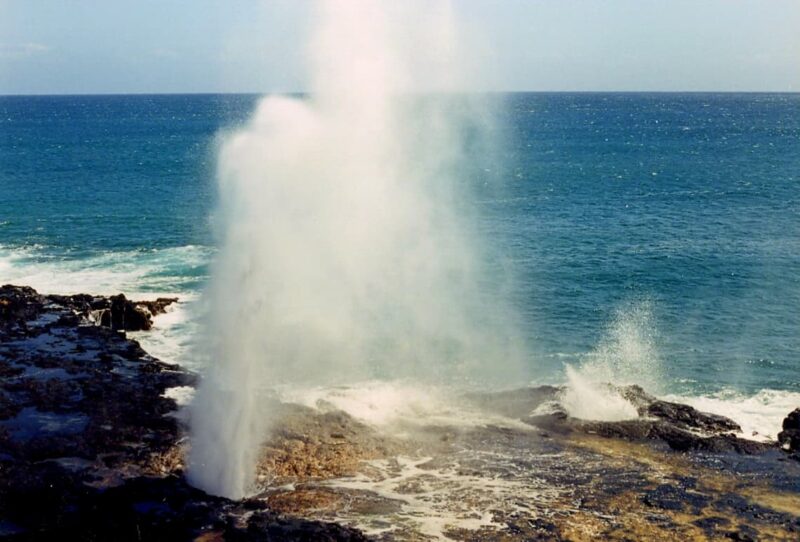
The Spouting Horn blowhole on Kauaʻi. Ron Clausen, CC BY-SA 4.0, via Wikimedia Commons
What’s in a Lava Tube: Caves, Blowholes, and Arches (and where to find them)
Lava tubes can take a variety of sizes and shapes, including caves, caverns, blowholes, and underwater sea caves that can be explored via foot, boat, or scuba/snorkeling.
1: Inland Lava Tubes (Caves and Caverns)
When exploring inland, you can find lava tubes in the form of caves and caverns. In some cases, the entrances are big and easily accessible, their exploration akin to exploring a cave. Bring a flashlight or headlamp!
For example: the Kaumana Caves (Hilo, Big Island)
A good example of an inland lava tube is the Kaumana Cave complex which we just discussed (see above). These caves are part of a 25-mile long lava tube that was created by a 1881 flow from the Mauna Loa volcano. You can explore the caves a short way in both directions before the lava tube enters private property.
2: Coastal Lava Tubes (Caves)
Many lava tubes made their way down to the coast, dumping their lava into the ocean. There are preserved examples of these coastal caves found throughout the islands, and some are accessible/visible straight from the beach or via boat tours.
For example: the sea caves at the Napali Coast (Kauaʻi)
There are many lava caves around the Hawaiian islands, but the most spectacular caves are found on the Nā Pali Coast on Kauaʻi. Access to these caves is only possible over the water by boat or kayak.
Pukalani (Open ceiling cave, see picture below) was once a far smaller lava tube. Erosion by the powerful sea waves over many many years caused the ceiling to collapse and created the wonders that you can visit today.

There are many sea caves along the Napali coast on Kauaʻi. Of those caves, Pukalani (the Open Ceiling Cave) is the most popular one. Credit: Hawaii Tourism Authority (HTA) / Tommy Lundberg
3: Blowholes
In their youngest form, lava tubes are like enclosed, underground tubes. But as time passes, erosion takes place and alters their composure. Eroded-away remnants of lava tubes are found everywhere across the islands. Sometimes, they can take the form of blowholes, through which waves crash with great force. Always enjoy from a distance!
For example: the Halona blowhole on Oʻahu
The most famous blowhole of Hawaiʻi is the Halona blowhole on Oʻahu (see above). You can easily see it from its dedicated overlook + parking lot, and add in a visit to one of the smallest beaches of the state (see link below the video).
To see the blowhole you need to park at the Halona Blowhole Lookout parking lot, which also gives access to the Halona Beach Cove on Oʻahu.
4: Underwater Sea Caves and Arches
Did you know that the Hawaiian islands are sinking? The Big Island for example, is sinking at a rate of nearly one tenth of an inch each year. While this doesn’t sound like a lot it does add up over time, and it is the reason there are so many underwater sea caves here!
Many old lava tubes are submerged underwater in the form of sea caves, arches, and other rock formations. Some of the sea caves can be explored by scuba, snorkeling, and free diving. When exploring underwater lava tubes, one must be extremely careful; they are recommended for experienced divers only.
For example: Tunnels (Makua) Beach on Kauaʻi
Tunnels (discussed above) is a popular snorkeling and diving spot on Kauaʻi brcause of the many underwater caverns you can find offshore.
